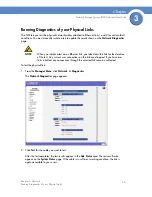
42
Chapter 4: Storage
Choosing a RAID Array Level
Network Storage System (NSS) Administrator Guide
Chapter
4
Choosing a RAID Array Level
RAID (Redundant Array of Inexpensive Disks) is a technology that enables multiple low-cost hard
drives to be used together in a way that increases performance and/or reliability compared to that
of a single drive. The component devices in a RAID array appear as a single logical storage device.
There are various types of RAID, referred to as RAID levels. Some RAID levels increase the
performance of the array, some increase the reliability, and others do a mixture of both. The NSS
supports the following RAID levels: 0, 1, 5 and 10. The NSS also supports JBOD (Just a Bunch of
Disks), which is not technically a RAID level.
The following variables are used in formulas below which explain how to calculate the total capacity
of each RAID level:
• m – capacity of the smallest disk in the array
• n – number of disks in the array
RAID0:
RAID0 stripes the data written to the array across the component disks. The data is broken
into chunks and each chunk is written to a different disk. Reads and writes to each disk occur in
parallel, speeding up the total read and write performance of the array.
•
Minimum Number of Disks:
2
•
Total capacity:
m x n
•
Advantages:
Increased read and write performance.
•
Disadvantages:
Decreased reliability. A failure of any component disk in the array causes the
entire array to fail.
RAID1:
RAID1 writes the same data to each disk in the array. The disks are referred to as “mirrors”
because each one mirrors the data stored on the others. As long as one disk in the array is intact, all
data can be read back from the array. If a disk fails in the array and is subsequently replaced, the
array must copy the entire contents of a good disk to the new disk. This process is referred to as
“resynching”. During a resync, the array continues to be available for reads and writes. When an
array contains a failed disk, it is said to be operating in “degraded” mode. This reflects the
decreased performance and reliability of the array when it is missing disks.
•
Minimum Number of Disks:
2
•
Total capacity:
m
•
Advantages:
Increased reliability. The array can sustain the loss of all but one disk without
any data loss. Each mirror disk added to the array increases the reliability (for example, a
two-disk RAID1 is half as likely to fail, a three-disk RAID1 is one-third as likely to fail, and so
on). Increased read performance
•
Disadvantages:
Decreased aggregate storage capacity (each mirror disk does not contribute
to the total capacity of the array). Decreased write performance. I/O intensive when
resynching mirrors.
RAID5:
RAID5 stripes data written to the array like RAID0, except that, unlike RAID0, RAID5
generates parity information that also gets striped across the array. This parity information is used to
















































